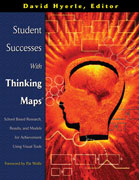



 dent Successes With Thinking Maps®
dent Successes With Thinking Maps®David Hyerle, editor with Sarah Curtis and Larry Alper co-editors
Chapter 14: Stories From Mississippi: Results From College to Kindergarten
Marjann Kalehoff Ball, Ed.D.
“Why did I have to be in college before I learned about thinking maps?”
“May I take these home to my children?”
“I helped my child with his bubble map last night and he helped me with mine.”
Students
After I used the maps for several years in my college classes, it was deemed feasible to determine whether or not the maps, interwoven with an existing college reading course, would have a significant effect on reading scores or be affected by the status (traditional/nontraditional) of the student. The investigation was conducted over two semesters with a sample of 92 students forming the control and experimental groups. Determination was made as to whether the treatment of mapping had resulted in a significant difference in reading scores as well as on which variables of fast reading, phonics, comprehension, scanning, structure, vocabulary, and word parts the mapping and no mapping groups differed. Necessary calculations were made using the multivariate analysis of covariance (MANCOVA) using the Wilk’s lambda criterion. Follow-up univariate analyses were utilized to clarify any significant multivariate results.
Statistically significant main effects were found for the treatment. There were no significant main effects for status, nor was there a significant interaction between treatment (mapping/no mapping) and status (traditional/nontraditional). Significant differences at the .01 level were found for five out of seven subtests of fast reading, comprehension, structure, vocabulary, and word parts, with the mapping group outperforming the no mapping group on each of the five variables. The findings of the univariate treatment by status analysis of covariance were consistent with the results of the multivariate analysis, which found that only the main effects for treatment were statistically significant. No statistically significant effects were found for status, nor was interaction between treatment and status statistically significant. It may be concluded that mapping made a significant difference on reading test scores.
Student Successes With Thinking Maps including the following sections in Linking Brain Research to Best Practices:The ripple effect from the utilization of thinking maps is amazing. Based on the success of students in my college classes as well as the achievements of my student Diana and the interest of other nursing students and the nursing instructors, a pilot program was set up in spring 2002 at JCJC by which entering LPN students would be instructed in the use of thinking maps in their nursing courses. Upon taking the exit exam at the conclusion of the structure and function course, 100% of the students passed the exam, the first time this had occurred in 17 years. Another group of entering LPN students was taught thinking maps in spring 2003, with a 100% passing rate on the Comprehensive Fundamentals of Nursing Exam (Educational Resource Inc., Fundamentals of Nursing) given at the end of the semester. Sandra Waldrup, the director of practical nursing said, “The Practical Nursing faculty is constantly trying to identify methods which would make learning and retention easier for our students. The volume of information they need can be overwhelming. Thinking Maps provide a consistent way to organize and link related concepts into a manageable system. Our students benefit from Thinking Maps as indicated in their evaluations.
Read the complete chapter in the book Student Successes With Thinking Maps. Key sections from the chapter The Mississippi Story with excerpts above include:
- Effective Strategies for Reading Comprehension
- From Pilot Project to Campus Wide Applications
- From College to Kindergarten
- From Reading Comprehension to Writing Proficiency
- The River Runs Deep and Wide
- Bridging the Generation Gap
 Marjann Kalehoff Ball, Ed.D. is a professor of English and Development of Critical Thinking and Study Skills at Jones County Junior College in Mississippi, and serves as a consultant for Innovative Learning Group. Believing that learning is a continuing process that can be fostered across all levels of education, she is convinced that Thinking Maps are an indispensable tool of learning for age or ability differentiations.
Marjann Kalehoff Ball, Ed.D. is a professor of English and Development of Critical Thinking and Study Skills at Jones County Junior College in Mississippi, and serves as a consultant for Innovative Learning Group. Believing that learning is a continuing process that can be fostered across all levels of education, she is convinced that Thinking Maps are an indispensable tool of learning for age or ability differentiations.
![]() Click here (pdf file) to download Research Highlights from
Click here (pdf file) to download Research Highlights from
Student Successes With Thinking Maps
For more on Student Successes With Thinking Maps go to the following links: